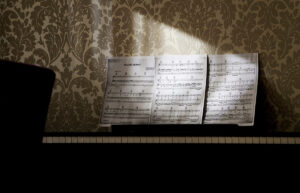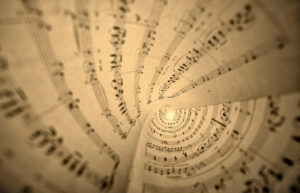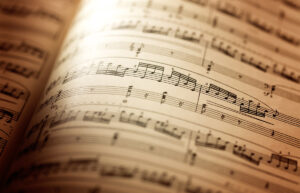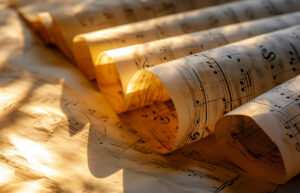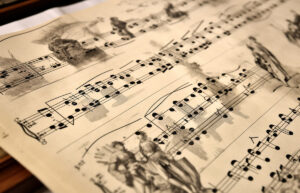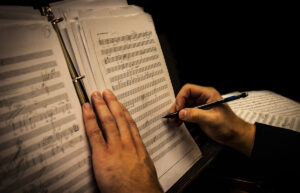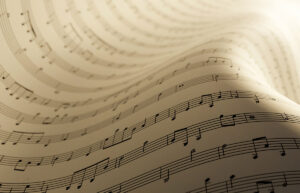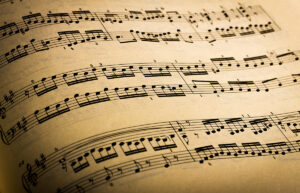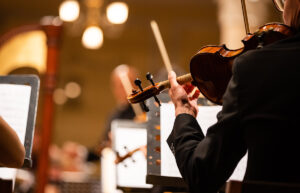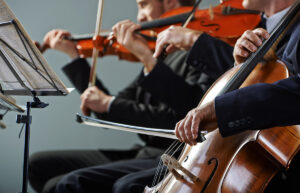What is a Melody in Music? Meaning, Types, Steps & Examples

Dive into the world of melodies with insights into history, types, characteristics, and examples in songs. Explore melody motion, its types and learn how to craft your own with practical tips on musical composition. This article also covers the differences between Melody and Harmony.
Welcome to TheDemoStop, now join the community!
Connect with artists, fans and producers around the world.
What is melody in music?
A melody is a sequence of single pitches that make a musical phrase. Essentially, melody is like the sweet icing on the cake of music. It’s the part you hum along to, the tune that sticks in your head.
It’s usually the most straight part of music because it’s the main tune or theme that everyone knows. Most melodies are made up of several musical phrases. Each phrase comprises a set of notes that make up a musical idea together.
Picture it like the lead actor in a movie. The melody takes the spotlight while harmony and rhythm are the supporting cast. It’s what gives a song its identity and emotional flavor. Melodies can be simple and catchy or intricate and complex, but their job is to grab your attention and make you feel something. Whether it’s a pop song or a classical piece, the melody often lingers in your mind, making it a crucial element in the art of sound.
History of melody
Ancient civilizations
In ancient civilizations, melodies were inseparable from communal life and religious practices. The Greeks, mainly, laid the groundwork for western music theory, introducing early concepts of scales and modes that influenced the development of melodies.
Medieval and Renaissance periods
The medieval period saw the dominance of Gregorian chants featuring monophonic melodies in religious contexts. The Renaissance brought a revolution with polyphony, enabling the intertwining of multiple melodies, marking a significant shift in musical expression.
Baroque era
The Baroque era was characterized by ornate and elaborate melodies, often adorned with intricate ornamentation. Composers like Johann Sebastian Bach exemplified this period’s emphasis on virtuosic and expressive melodic lines.
Classical period
The Classical era prioritized clarity and balance in melodies. Composers such as Haydn, Mozart, and Beethoven refined melodic structures within the rules of classical forms, laying the foundation for a more structured approach to composition.
Romantic era
In the Romantic era, melodies took on a new dimension, emphasizing emotional depth and expression. Composers like Chopin and Schubert explored the full spectrum of human emotion through sweeping and passionate melodic lines, breaking away from the formality of the past.
20th century
The 20th century witnessed a shift in melodic expression. In the early part of the century, jazz revolutionized melodies with improvisation and syncopation, offering a departure from traditional Western conventions. The rise of popular music, rock, and electronic genres further expanded the possibilities of melodic composition.
Contemporary era
In the contemporary era, melody continues to evolve dynamically. Genres like hip-hop introduce innovative melodic elements, often mixed with electronic production techniques. The globalization of music and technological advancements have facilitated the cross-pollination of melodies from various cultures, creating a diverse and interconnected musical experience. Melodies, throughout history, have been a reflection of societal changes, artistic experimentation, and the universal language of human emotion.
Importance of melody in music
- Memorable identity and emotional impact: Catchy melodies act like musical Velcro, sticking in your head and evoking a range of emotions, providing an instantly recognizable and emotionally resonant experience.
- Unifying element and narrative guide: Melodies lead in ensembles, weaving harmonies and rhythms, providing a unifying force and guiding listeners through musical tales with rises, falls, and twists.
- Universal expression and cultural essence: Like words convey meaning in language, melodies communicate emotions in music, transcending linguistic barriers and encapsulating the essence of a culture, from traditional folk tunes to contemporary anthems.
- Infectious hooks and artistic signature: A good melody has hooks, irresistibly grabbing your ear and becoming an earworm. It also serves as the unique creative signature of composers and songwriters, defining their legacy and expressing their distinctive voice.
Types of melodies in music
Ascending melody
An ascending melody is like a musical hiking, a journey that goes up the scale. It’s characterized by a series of pitches that gradually rise in pitch, creating a sense of upliftment and positivity. This melody often conveys a feeling of optimism or anticipation, as if climbing towards a musical peak.
Descending melody
In contrast to the ascending melody, a descending melody is a musical descent—a journey that moves down the scale. It imparts a sense of resolution or contemplation. Descending melodies often create a feeling of calm or introspection, like a musical sigh.
Jump and skip melody.
A jump and skip melody is like a playful dance across the musical world. Instead of moving stepwise, it involves leaps and skips between notes. This melody can add a sense of unpredictability and liveliness to a composition. It’s like musical hopscotch, keeping the listener engaged and adding a dynamic, playful quality to the overall sound.
Rhythmic melodies
Rhythmic melodies focus not only on the pitch but also on the timing and duration of the notes. They play with the rhythm, creating patterns and accents that contribute to the overall groove of the music. Whether it’s syncopated or steady beats, rhythmic melodies add a layer of excitement and energy. They’re like the heartbeat of the composition, driving the momentum and making you want to move to the rhythm.
Arpeggiated melody
Arpeggiated melodies unfold like a musical waterfall, where the notes of a chord are played in a sequence rather than simultaneously. This flow creates a lyrical effect, often associated with grace and elegance. Arpeggiated melodies are found in various genres, from classical music to pop sonnets, and they add a touch of sophistication and fluidity to the overall chorus.
Call and response
Call and response is a dynamic interaction between different musical phrases or voices. It’s like a musical conversation, where one part (the call) is answered by another (the response). This melody is often used in folk, blues, and jazz music, creating a dialogue between instruments or lyrics. Call and response adds a sense of dialogue and tension, keeping the listener engaged as the musical conversation unfolds.
Characteristics of melodies in music
Pitch
Pitch is the foundational element of melody, representing the perceived highness or lowness of a musical sound. In melodies, pitches are organized into patterns, creating a sequence of notes that form the tune. The interplay of different pitches gives a melody its distinct character, whether a soaring high or grounding low note. Pitch manipulation is a powerful tool for composers and musicians to convey emotion, create tension, or establish a memorable musical identity.
Length of melodic line
The length of a melodic line refers to how many notes or beats the melody spans. Some melodies are short, while others are expansive. The length contributes to the overall structure of the melody, influencing the listener’s sense of continuity. Short, punchy pieces might be catchy and memorable, while longer, unfolding lines can create a sense of narrative or journey within the music.
Timbre and tone
Timbre, or tone color, is the unique quality of a sound that differentiates it from others. In melodies, the choice of instruments or voices contributes to the timbral palette. The timbre affects the mood and character of the melody—whether warm and mellow, bright and sharp, or somewhere in between. Timbral variations add layers of richness to a melody, allowing it to evoke different emotions and textures.
Contour and melodic motion
The contour of a melody describes the shape of its rise and fall in pitch. Melodic motion refers to the direction and pattern of these pitch changes. A melody can have a smooth, ascending contour, creating a sense of ascent and optimism, or a jagged, descending contour, suggesting a fall or resolution. Melodic motion, whether stepwise or by leaps, influences the flow and expressiveness of the melody, shaping its overall emotional impact.
Rhythm
Rhythm is the heartbeat of a melody, determining the timing and duration of each note. An unsteady rhythmic pattern creates a sense of tension and excitement, while a regular one provides a sense of stability. The interplay between rhythm and melody is crucial for establishing the groove and feel of a piece of music, making you tap your foot or sway to the beat.
Dynamics
Dynamics in melody refer to the variations in volume or intensity. A melody can be played softly, creating a close-knit atmosphere or inspiring power and vigor. Dynamic changes add a sense of drama and contrast to the melody, shaping its emotional intensity and engaging the listener’s attention.
Harmony
Harmony is the simultaneous combination of different pitches in music. While melody focuses on a single line of pitches, harmony involves blending multiple lines. In melodies, harmony can influence the overall mood and color by providing a supportive backdrop or creating tension through dissonance. The relationship between melody and harmony is a key aspect of musical composition, influencing the harmonic character of a song piece.
Scale
Scales form the building blocks of melodies, providing the pool of pitches from which a melody is drawn. Whether it’s a major scale for a bright and happy melody or a minor scale for a more somber or mysterious tone, the choice of scale sets the tonal foundation. Scales contribute to a melody’s character and mood, guiding the composer or improviser in selecting the right notes to convey the desired emotion or atmosphere.
Welcome to TheDemoStop, now join the community!
Connect with artists, fans and producers around the world.
How to write a melody?
Find your scale
Begin by selecting a musical scale that suits the mood or emotion you want to convey. Whether it’s major, minor, or a more exotic scale, this sets the foundation for your melody.
Build onto a chord progression
Identify or create a chord progression that complements your chosen scale. The harmony provided by the chords will guide the direction of your melody, influencing the emotions it conveys.
Start with rhythm and lyrics
Consider crafting a rhythmic pattern and, if applicable, lyrics that align with the mood or theme of your melody. This rhythm set can be a stepping stone for developing the melodic structure.
Improvise
Let your creativity flow by improvising on your chosen scale over the set chord progression. This freestyle exploration allows you to discover interesting melodic phrases and ideas.
Work on the verse melody first
Focus initially on developing the melody for the verse. This section often establishes the core musical ideas and themes, providing a solid framework for the rest of the composition.
Come up with multiple options
Generate several melody options for each section of your song. Experiment with different intervals, rhythms, and phrasing to find the best combination with the desired emotion and atmosphere.
Let the melodies sit
Take a step back and give your melodies some breathing room. Allowing them to sit for a while can provide a fresh perspective when you revisit them later.
Edit as needed
Review and refine your melodies with a critical ear. Make adjustments to enhance the flow, emotional impact, and overall cohesion of the melody within the context of the song.
Rinse and repeat
Don’t be afraid to go through the process multiple times. Each iteration allows you to refine and polish your melody, ensuring it aligns seamlessly with the song’s theme and structure.
Examples of melodies in popular songs
“The Beautiful Blue Danube” – Strauss
Characteristics:
- Waltz structure: This melody is a classic example of a waltz, characterized by its 3/4 time signature and graceful, flowing rhythm.
- Elegant and sweeping: The melody has a sleek quality, mirroring the graceful flow of the Danube River.
- Orchestral brilliance: Strauss employs the full sensation of the orchestra with soaring strings and delightful woodwind melodies.
Impact:
- Cultural icon: “The Beautiful Blue Danube” is a cultural icon often associated with Vienna and the elegance of Strauss’s compositions.
- Celebratory atmosphere: The melody is commonly associated with celebrations and formal events, adding a touch of grandeur to the occasion.
Memorable elements:
- Lyrical Viennese phrasing: The melody features Viennese phrasing, with expressive rises and falls contributing to its memorable and singable nature.
- Iconic Waltz theme: The recurring waltz motif is instantly recognizable and contributes to the timeless appeal of the melody.
“Yesterday” by The Beatles
Characteristics:
- Simple and melancholic: Its simplicity and melancholic beauty describe the melody.
- Folk-inspired: The melody has a folk-inspired theme paired with acoustic guitar, emphasizing Paul McCartney’s expressive vocals.
- Memorable chorus: The chorus features a striking and timeless melodic line, enhancing the song’s emotional impact.
- Descending Melody: “Yesterday” features a descending melody. The melodic line moves downward, contributing to the reflective and poignant mood of the song.
Impact:
- Timeless classic: “Yesterday” is considered one of The Beatles’ timeless classics, showcasing their versatility and songwriting prowess.
- Global recognition: The melody’s international recognition has contributed to its status as one of the most covered songs in the history of recorded music.
Memorable elements:
- Catchy opening line: The opening line, “Yesterday, all my troubles seemed so far away,” is an immediately recognizable and iconic part of the melody.
- Emotional resonance: The melody’s emotional resonance and McCartney’s heartfelt delivery make it a standout.
“In the Mood” – Glenn Miller Orchestra
Characteristics:
- Swing and big band: The melody is an ideal example of the swing and big band era.
- Upbeat and energetic: With a lively and spirited tempo, the melody invites listeners to dance and captures the vibrant spirit of the swing era.
- Call and response: The melody features call and response elements, creating a dynamic interaction between different orchestra sections.
Impact:
- Swing era staple: “In the Mood” is a staple of the swing era, representing the high-spirited atmosphere of dance halls.
- Iconic arrangement: The iconic arrangement, led by Glenn Miller’s orchestra, contributes to the enduring popularity of the melody.
Memorable elements:
- Saxophone riff: The memorable saxophone riff at the beginning is instantly recognizable and sets the tone for the infectious melody.
- Danceable groove: The melody’s groove and contagious energy make it a timeless favorite for swing dance enthusiasts.
“Canon in D” by Johann Pachelbel
Characteristics:
- Canon form: The melody is structured as a canon, where a musical idea is imitated and layered, creating a rich and harmonically satisfying texture.
- Arpeggiated melody: “Canon in D” features an arpeggiated melody. The notes of the chords are played in a broken or staggered fashion, creating a flowing and cascading effect.
- Graceful and majestic: With its classy and exquisite quality, the melody exudes a sense of elegance and stateliness.
- Baroque Harmony: Pachelbel’s use of Baroque harmony provides a solid foundation for the layered canon, creating a sense of continuity and resolution.
Impact:
- Wedding favorite: “Canon in D” has become famous for weddings, conveying a sense of timelessness and celebration.
- Cultural legacy: The melody’s enduring popularity has cemented its place in classical music and popular culture.
Memorable elements:
- Ground bass pattern: The repeating pattern provides a stable foundation for the canon and contributes to the melody’s enduring appeal.
- Gradual escalation: The melody builds gradually as each layer is added, creating harmonic richness and emotional depth.
Welcome to TheDemoStop, now join the community!
Connect with artists, fans and producers around the world.
Melodic motion
Conjunct melodic motion
Definition:
In conjunct melodic motion, the melody moves primarily by step, with small intervals between successive pitches.
Characteristics:
- Smooth and connected: Conjunct motion creates a smooth and connected flow, contributing to a sense of continuity in the melody.
- Gradual changes: Melodic phrases with conjunct motion often show gradual changes, providing ease and predictability.
Disjunct melodic motion
Definition:
Disjunct melodic motion involves larger intervals between successive pitches, creating leaps or jumps in the melody.
Characteristics:
- Energetic and dramatic: Disjunct motion adds energy and drama to a melody, creating a more dynamic and expressive character.
- Attention-grabbing: Leaps in the melody can grab the listener’s attention, adding variety and unpredictability to the musical line.
Mixed melodic motion
Definition:
Mixed melodic motion combines both conjunct and disjunct elements within the same melody.
Characteristics:
- Varied and dynamic: Mixed motion balances the smoothness of conjunct motion and the excitement of disjunct motion, offering a diverse and dynamic melodic experience.
- Versatility: Composers often use mixed motion to achieve a range of emotional effects, allowing for gentle, flowing sections and more intense, dramatic moments in the melody.
Parallel melodic motion:
Definition:
In parallel melodic motion, two or more melodic lines move in the same direction, maintaining a consistent interval relationship.
Characteristics:
- Harmonically rich: Parallel motion can create harmonically rich sound textures as the intervals between the melodies remain constant.
- Unison or parallel harmony: When the melodies move in exact unison, it makes a strong sense of unity. If the intervals are maintained but not unison, it produces parallel harmony, adding depth and sophistication to the musical.
Difference between melody and harmony
Definition
Melody is the heart and soul of a musical composition, representing a sequence of single pitches that form a cohesive and memorable melodic line—the tune that we hum, whistle, or sing along to.
On the other hand, harmony is the art of combining different pitches played or sung simultaneously, creating chords and a fuller, more complex sound.
Horizontal vs. Vertical
The nature of melody is inherently horizontal, unfolding sequentially through time as it guides the listener on a linear journey.
In contrast, harmony is vertical, as it involves simultaneously sounding multiple pitches, each contributing to the overall chordal structure.
Single line vs. Multiple lines
Melody is typically a single line of musical notes, emphasizing the individual lyrical line that carries the main theme or idea.
However, harmony involves multiple lines of musical notes co-occurring, creating a harmonic canvas that supports and complements the melody.
Primary focus
While melody is the focal point, emphasizing the individual musical line, harmony plays a supporting role. It enhances the overall composition by providing depth, texture, and a harmonic backdrop against which the melody can shine.
Expression of emotion
Melody conveys emotion through the rise and fall of individual pitches in a linear fashion. The contour of the melody, along with the dynamics and phrasing, contributes to the emotional impact.
Harmony, on the other hand, conveys emotion through the blending and interaction of different pitches played together, creating chords that evoke specific feelings.
Role in music
Melody often serves as the lead or main theme of a musical piece. It is the part that listeners tend to remember most.
Harmony, meanwhile, plays a crucial role in supporting the melody, providing the harmonic framework that defines the overall tonal character of the music.
Compositional element
Melody is a fundamental and essential element in music composition. It’s often the hook, the part that listeners latch onto.
Harmony, while equally essential, enhances the overall composition by adding layers of sound. It contributes to the richness and complexity of the musical arrangement.
Welcome to TheDemoStop, now join the community!
Connect with artists, fans and producers around the world.
Conclusion
Melody definition: Melody is the order of musical notes that make up a unique tune. It’s the main thing that grabs your attention and gives a piece its personality.
History of melody in music:
From ancient rituals to intricate Gregorian chants, it evolved through polyphony, ornate Baroque compositions, and balanced Classical structures. The Romantic era brought emotional depth, expanding orchestration, while the 20th century witnessed diverse styles from atonal to jazz. In the contemporary landscape, melodies fuse genres influenced by electronic elements.
Importance of melody in music:
Melodies are powerful emotional conduits, forging a direct bond with the audience. Their catchiness cements a song’s popularity and offers a guiding thematic framework. Beyond this, melodies communicate a piece’s mood, narrative, and essence, captivating and engaging listeners.
Types of melodies: Some of the different types of melodies include ascending, descending, jump and skip, rhythmic, arpeggiated, and call and response melody.
Characteristics of melodies: Pitch, timber and tone, rhythm, harmony, and scale are what makes a melody.
How to write a melody?
To create a compelling melody, start with a chosen scale and complementary chord progression. Begin with rhythm and, if applicable, lyrics that match the mood. Improvise within your chosen scale. Focus on the verse melody first. Generate options for each section, then take breaks for fresh perspective. Review and refine for flow and emotional impact. Repeat until you find the perfect melody.
Examples of melodies in popular songs:
- “The Beautiful Blue Danube” – Strauss
- “Yesterday” by The Beatles
- ‘In the Mood’ – Glenn Miller Orchestra
- “Canon in D” by Johann Pachelbel’s
Types of melodic motion:
The four types are conjunction, disjunction, mixed melodic, and parallel melodic motion.
Difference between melody and harmony:
Melody is the main sequential arrangement of pitches, while harmony involves simultaneous pitch combinations, creating a fuller sound. The melody moves horizontally and is a standalone line conveying emotion. It often serves as the lead theme. Harmony operates vertically, combining multiple lines for a unified sound, providing depth and texture to support the melody.
FAQs
What is melody in music?
Melody in music is the leading, recognizable tune created by a sequence of single pitches or notes. It forms the heart of a composition with distinctive characteristics such as pitch, rhythm, and contour. Melodies provide cohesion and emotional expression within a piece, serving as a star element that captures the listener’s attention and defines the musical essence.
What are the different types of melodies?
Ascending, descending, jump and skip, rhythmic, arpeggiated, and call-and-response melodies are some of the different melodies.
What are the characteristics of melodies?
Pitch, length of melodic line, timbre and tone, contour and melodic motion, rhythm, dynamics, harmony, and scale are key elements influencing the character and structure of a melody in music.
How to write a melody?
To make a great melody, start with a set of notes and chords that go together. Add a rhythm and, if needed, words that fit the feeling. Play around with the notes. Focus on the main tune for the verse. Review and improve the flow and feeling. Keep trying different ideas until you find the perfect melody.
What are the examples of melodies in popular songs?
“Shape of You” by Ed Sheeran: Ed Sheeran’s “Shape of You” features a catchy and upbeat, ascending melody that drives the pop song. The repetitive yet infectious melodic pattern contributes to the song’s popularity.


















